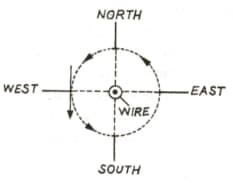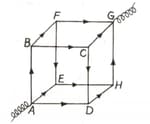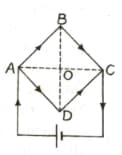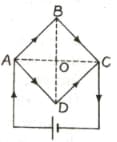Two parallel wires carry currents in opposite directions. What is the nature of force between them in each case?

Important Questions on Moving Charges and Magnetic Field
A straight, current-carrying wire is buried into a wall erected in the north-south direction.The north pole of a horizontal magnetic needle placed near the wall towards its west points towards south (instead of north). What is the direction of the wire buried in the wall and what is the direction of current in it?

What will be the magnetic field at the centre of the cube made of wires, shown in the figure?

Four copper wires of same cross-sectional area are connected in the form of a square . On passing currents in them, as shown in the figure, will a magnetic field be produced at the centre of the square ?

Four wires of same cross-sectional area are connected together to form a square ABCD.If the wires, and are of copper, and and of aluminium, then Will the magnetic field is produced at O of square ABCD?

